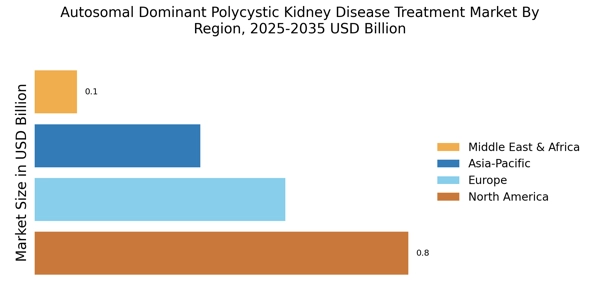Advancements in Research and Development
Ongoing advancements in research and development are significantly influencing the Autosomal Dominant Polycystic Kidney Disease Treatment Market. Pharmaceutical companies are investing heavily in the discovery of novel therapeutic agents aimed at slowing disease progression and improving patient outcomes. For instance, recent clinical trials have shown promising results for new drug candidates, which could potentially reshape treatment paradigms. The market is witnessing a surge in the development of targeted therapies, which are designed to address the underlying mechanisms of ADPKD. This focus on innovative treatment options is expected to enhance the overall efficacy of therapies available, thereby attracting more investment and interest in the Autosomal Dominant Polycystic Kidney Disease Treatment Market.
Growing Awareness and Education Initiatives
The increasing awareness and education initiatives surrounding Autosomal Dominant Polycystic Kidney Disease are contributing to the growth of the Autosomal Dominant Polycystic Kidney Disease Treatment Market. Healthcare organizations and advocacy groups are actively promoting education about the disease, its symptoms, and the importance of early diagnosis. This heightened awareness is likely to lead to earlier interventions and increased patient engagement in treatment decisions. As patients become more informed about their condition, they may seek out available therapies, thereby driving market demand. Additionally, educational campaigns can foster a better understanding of the disease among healthcare professionals, which may improve diagnosis rates and treatment outcomes in the Autosomal Dominant Polycystic Kidney Disease Treatment Market.
Regulatory Support for Innovative Therapies
Regulatory bodies are increasingly providing support for the development and approval of innovative therapies for Autosomal Dominant Polycystic Kidney Disease, which is positively impacting the Autosomal Dominant Polycystic Kidney Disease Treatment Market. Initiatives such as expedited review processes and orphan drug designations are encouraging pharmaceutical companies to invest in research and development. This regulatory environment is conducive to the introduction of new treatment options that may significantly improve patient outcomes. As more therapies receive regulatory approval, the market is likely to expand, offering patients a wider array of choices. This supportive regulatory framework is essential for fostering innovation and growth within the Autosomal Dominant Polycystic Kidney Disease Treatment Market.
Increasing Investment in Healthcare Infrastructure
The growing investment in healthcare infrastructure is a crucial driver for the Autosomal Dominant Polycystic Kidney Disease Treatment Market. Enhanced healthcare facilities and improved access to medical services are enabling better diagnosis and treatment of ADPKD. Governments and private entities are recognizing the need for robust healthcare systems to manage chronic diseases effectively. This investment is likely to facilitate the availability of advanced diagnostic tools and treatment options, thereby improving patient outcomes. As healthcare systems evolve, the demand for effective therapies in the Autosomal Dominant Polycystic Kidney Disease Treatment Market is expected to rise, reflecting the need for comprehensive care solutions.
Rising Prevalence of Autosomal Dominant Polycystic Kidney Disease
The increasing incidence of Autosomal Dominant Polycystic Kidney Disease (ADPKD) is a primary driver for the Autosomal Dominant Polycystic Kidney Disease Treatment Market. Recent estimates suggest that ADPKD affects approximately 1 in 400 to 1 in 1,000 individuals, leading to a growing patient population requiring effective treatment options. This rising prevalence is likely to stimulate demand for innovative therapies, as healthcare providers seek to manage the disease more effectively. Furthermore, as awareness of the condition increases, more patients are being diagnosed, which could further expand the market. The need for effective management strategies and therapies is becoming increasingly urgent, thereby propelling the growth of the Autosomal Dominant Polycystic Kidney Disease Treatment Market.


















Leave a Comment